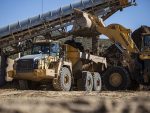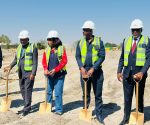Galp Energia, which has spudded the Mopane 1-A well as part of the second exploration and appraisal campaign in PEL 83 in Namibia’s Orange basin has slashed well costs to around US$75 million (about N$1.3 billion) per well, Business Express understands.
This was revealed by CEO Filipe Silva who told analysts during Galp’s third-quarter earnings presentation last week.
Silva attributed this to better knowledge of its drilling environment and “a lot more competition from service providers.”
The pivotal four-well exploration and appraisal campaign offshore Namibia which kicked off last week is being conducted at blocks 2813A and 2814B, where Galp is the operator with 80% stake, with Custos Energy and NAMCOR, the National Petroleum Company of Namibia, holding 10% each. Sintana maintains an indirect 49% interest in Custos Energy.
Galp and its Namibia partners started off with an appraisal well, spudded on Oct. 23 close to the original discoveries, and results are expected this year, which should help re-risk an initial development.
Next up is expected to be an exploration well, located southeast of Mopane in the PEL 83 license’s other block, 2814B. However, the second well is not due to be drilled until June 2025, allowing sufficient time to study seismic activity.
“That, in itself, will likely trigger a number of other wells in the region,” Silva explained. It could support a separate development, he added.
“We look forward to the continuing progress on PEL 83, further unveiling of the potential and quality of the Mopane complex. These efforts should provide additional insights into this world class opportunity and into our broader Orange Basin portfolio located at the heart of this emerging hydrocarbon province.” said Robert Bose, Chief Executive Officer of Sintana.
Initial analysis suggests the reservoirs have good porosities, high pressures, and high permeabilities in large hydrocarbon columns with very low oil viscosity and no CO2 or H2S. The flows achieved during the well test have reached the maximum allowed limits.
Saipem’s Santorini drillship which has been contracted by Galp is a seventh-generation drillship – acquired by Saipem in December 2022 – equipped with two seven-cavity anti-eruption devices (blow-out preventer or BOP) and capable of operating at water depths of up to 12,000 feet (over 3,500 meters). Eni exercised a two-year contract extension for the rig in April 2023.
Last year, Galp began to drill a well in license PEL 83 with the SFL Corporation-owned and the Odfjell Drilling-managed Hercules sixth-generation deepwater and harsh environment semi-submersible rig by spudding the Mopane-1X prospect in November 2023, which was the first of two wells planned to be drilled.
FARM-OUT PLANS DELAYED
Despite Galp having commenced drilling, it will likely not conclude a planned farm-out of its giant Mopane discovery until late next year, the firm revealed.
An announcement of a 40% operator for Mopane has been keenly anticipated, with both a senior executive at state-owned Namcor and a potential buyer recently suggesting that a deal was coming imminently.
“We remain very keen to hold onto our 80% stake in Namibia, at least until we get the results from our next two wells,” Silva said.
As such, a farm-out agreement will “wait until most likely end of 2025 and also to learn from what other players around us are going to find,” Silva said. These are very, very exciting times for Galp and for Namibia, he added.
The farm-out of Mopane, touted as a 10 billion barrels of oil equivalent in place discovery, has been one of the most closely watched M&A deals this year. A string of heavyweight suitors has been linked to the project, including Petrobras and a number of the oil majors.
Analysts at investment bank RBC Capital Markets suggested Mopane could also be a good fit for large US integrated companies that have been on the hunt for long-term oil and gas resources.
Chevron would be a natural acquirer of the portfolio and have the capacity to do so, the analysts noted.
COMMERCIALLY VIABLE
On April 21, the Galp announced that the Mopane find was likely to be commercially viable. According to Commodity Insights estimates, the Mopane field will see first oil in 2030 and will plateau at 211,000 boe/d in 2037.
The find sits to the north of the giant Venus and Graff discoveries by TotalEnergies and Shell respectively in early 2022, which sparked a rush for stakes in the Orange Basin from the world’s biggest exploration and production firms.
The Venus find, which could hold as much as 5 billion barrels of oil in place, according to the Namibian government, is expected to be the first oil project to come online in 2030, according to forecasts from Commodity Insights analysts.
TotalEnergies is planning for a 160,000 b/d development on Venus, CEO Patrick Pouyanne told analysts on Oct. 2, while also drilling other prospects in its Orange Basin acreage.
Commodity Insights forecasts suggest Namibian crude production from Venus, Jonker and Graff will reach 380,000 b/d by 2035, increasing further with additional discoveries.
That would make Namibia — which does not currently produce any hydrocarbons — a major African oil producer, transforming its economy.
OTHER PROJECTS
Both third-quarter cash flow and net oil and gas output were down around 10% compared to the same quarter in 2023, reflecting Galp’s disposal of its Area 4 assets in Mozambique.
Output should get a boost from the start-up of the Bacalhau field in Brazil next year.
But a key energy transition project, Galp’s planned Aurora lithium processing joint venture in Portugal, is on hold. “We are in no rush to take an FID [final investment decision] until we see an appropriate return for the project, and we don’t seem to be there as we speak,” said Silva.
The failure of lithium mining to take off in Portugal is another concern for the project, he noted.
While the outlook for renewable energy in Brazil has improved, it has not done so sufficiently for Galp to reactivate previous solar and wind plans, analysts heard.










